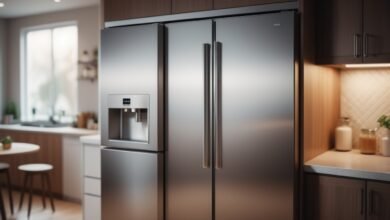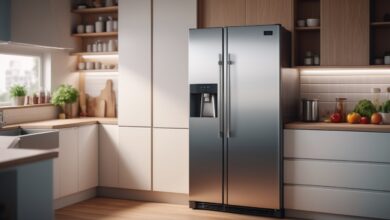Tips for Enhancing the Durability of Your Fridge

In the heart of every kitchen, the refrigerator stands as a stalwart guardian of freshness, preserving our food and ensuring our daily meals are both safe and delicious. To get the most out of this indispensable appliance, it’s crucial to implement strategies that enhance its durability. In this extensive guide, we will explore a multitude of tips and techniques to help you maximize the lifespan of your refrigerator, keeping it running efficiently for years to come.
Understanding Refrigerator Durability
Before we dive into specific tips, let’s take a moment to understand the key factors influencing the durability of refrigerators.
1. Built to Last
1.1 Quality Construction
The durability of a refrigerator often starts with its construction. High-quality materials such as stainless steel, tempered glass shelves, and robust plastic components contribute to an appliance that can withstand the rigors of daily use. When shopping for a new fridge, consider models from reputable brands known for their commitment to quality craftsmanship.
1.2 Innovative Technologies
Advancements in technology have paved the way for more durable and energy-efficient refrigerators. Look for features such as inverter compressors, which reduce wear and tear by adjusting cooling capacity based on demand. Additionally, dual evaporator systems help maintain optimal humidity levels in the fresh food and freezer compartments, enhancing food preservation.
2. Optimal Usage Practices
2.1 Temperature Management
One of the most critical factors in enhancing refrigerator durability is proper temperature management. Set the thermostat to recommended levels – around 37°F (3°C) for the refrigerator and 0°F (-18°C) for the freezer. Consistent temperatures not only keep your food fresh but also prevent the compressor from overworking, ultimately extending its lifespan.
2.2 Avoid Overloading
Resist the temptation to overload your refrigerator. Excessive items can obstruct airflow, forcing the compressor to work harder to maintain the desired temperature. Follow recommended storage guidelines, and periodically declutter to ensure optimal performance.
3. Cleaning and Maintenance
3.1 Interior Cleaning
A clean interior not only promotes hygiene but also contributes to the longevity of your fridge. Regularly remove expired items, spills, and debris. Clean shelves, drawers, and walls with a mild detergent solution, paying special attention to hard-to-reach areas. Additionally, clean the drain hole to prevent clogs that could lead to water accumulation.
3.2 Exterior Maintenance
The exterior of your refrigerator also requires regular attention. Wipe down surfaces with a soft cloth and a mixture of mild soap and water. Clean the condenser coils, typically located on the back or underneath the appliance, to ensure efficient heat exchange. Maintain cleanliness around the vent areas to facilitate proper ventilation.
4. Smart Organization
4.1 Strategic Placement
Organize your fridge strategically to optimize its performance. Store items with varying temperature requirements in appropriate zones – for example, dairy and eggs in the designated dairy compartment and vegetables in the crisper drawers. Place items that require a consistent temperature, like meats and dairy, towards the back where temperatures are more stable.
4.2 Temperature Zones
Refrigerators have different temperature zones, and understanding them can significantly enhance durability. Keep perishable items in the colder areas, such as the back of shelves and the bottom of the fridge, and reserve the door for condiments and non-perishables. This reduces temperature fluctuations and minimizes the workload on the compressor.
5. Routine Inspection and Repairs
5.1 Regular Check-ups
Implement a routine inspection schedule to catch potential issues early. Check door seals and gaskets for signs of wear or damage, ensuring they create a tight seal. Examine the thermostat, defrost system, and fans to verify proper functionality. Addressing minor issues promptly can prevent them from escalating and impacting the overall durability of the refrigerator.
5.2 DIY Repairs
Empower yourself with basic DIY repair skills to address minor problems. Learn to replace a faulty thermostat, door seal, or light bulb. Familiarize yourself with the refrigerator’s manual, which often contains troubleshooting tips and step-by-step instructions for common issues. Remember to disconnect the appliance from power before attempting any repairs.
6. Energy Efficiency Measures
6.1 Energy-Efficient Appliances
Investing in an energy-efficient refrigerator not only reduces your carbon footprint but also enhances the appliance’s durability. Look for models with ENERGY STAR certification, indicating compliance with stringent energy efficiency standards. Energy-efficient appliances typically operate with less strain, contributing to a longer lifespan.
6.2 Power Surge Protection
Protect your refrigerator from potential damage caused by power surges. Connect the appliance to a surge protector or a dedicated circuit to shield sensitive electronic components from voltage spikes. This simple precaution can prevent costly repairs and extend the overall durability of your fridge.
Advanced Strategies for Durability
7. Advanced Temperature Control
7.1 Smart Thermostats
Consider upgrading to a refrigerator with smart thermostat technology. These advanced systems can adapt to your usage patterns, optimizing cooling cycles and reducing unnecessary strain on the compressor. Smart thermostats also provide real-time monitoring, allowing you to adjust settings remotely for maximum efficiency.
7.2 Temperature Alarms
Some modern refrigerators come equipped with temperature alarms that alert you to fluctuations outside the desired range. Utilize these features to stay informed about potential issues, enabling quick intervention to prevent food spoilage and minimize strain on the appliance.
8. Condenser Fan Maintenance
8.1 Cleaning and Lubrication
The condenser fan plays a crucial role in dissipating heat from the refrigerator’s condenser coils. Regularly clean the fan blades to remove dust and debris that can hinder its operation. Additionally, lubricate the fan motor if your refrigerator’s manual recommends it. Proper maintenance of the condenser fan contributes to efficient heat exchange and extends the lifespan of the appliance.
9. Water Filter Replacement
9.1 Regular Replacement
If your refrigerator has a water and ice dispenser, replace the water filter at recommended intervals. A clogged or expired filter can strain the water dispensing system, affecting the overall efficiency of the refrigerator. Regular replacement ensures clean and refreshing water while contributing to the appliance’s durability.
Conclusion
Enhancing the durability of your refrigerator involves a combination of smart practices, regular maintenance, and, when possible, utilizing advanced technologies. By understanding the key factors influencing refrigerator lifespan and implementing the tips outlined above, you can ensure that your appliance not only stands the test of time but also operates at peak efficiency. Remember, consistent care and attention to detail are the foundations of a longer-lasting refrigerator, saving you money, reducing environmental impact, and providing peace of mind for years to come.






